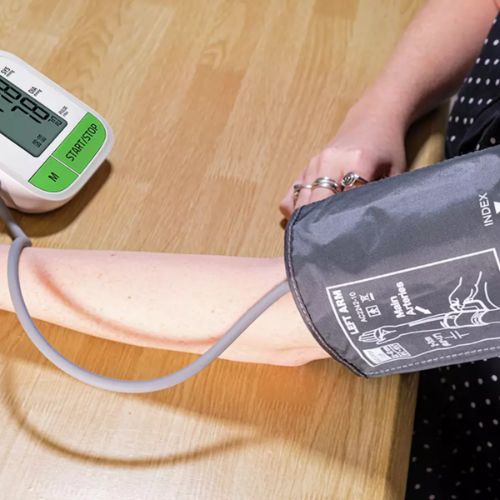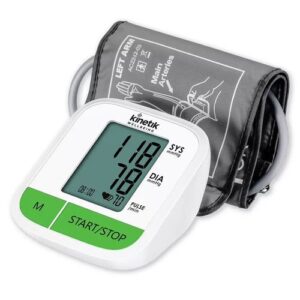Around 1 in 10 people in the UK suffer from low blood pressure, also known as hypotension. This article will explain what causes low blood pressure, when you should worry about it, and how to safely increase your blood pressure through lifestyle changes and medication if needed.
What is Low Blood Pressure?
Blood pressure is recorded with two numbers, for example 120/80 mmHg. The first, higher number is your systolic blood pressure. This represents the pressure in the blood vessels when the heart muscle squeezes and pumps blood around your body.
The second, lower number is your diastolic blood pressure. This is the pressure in the arteries when the heart relaxes between beats.
Low blood pressure, or hypotension, is typically defined as:
- Systolic (top number) less than 90 mmHg
- Diastolic (bottom number) less than 60 mmHg
However, some very fit people can have readings below this without issues. And others might get symptoms above 90/60 mmHg if their blood pressure drops a lot on standing up.
Low blood pressure that occurs mainly when standing up from sitting or lying down is called postural hypotension or orthostatic hypotension.
What Causes Low Blood Pressure?
There are many potential causes of low blood pressure:
Short Term Causes
- Dehydration – from diarrhea, vomiting, fever or heat
- Bleeding – including heavy periods
- Medications like diuretics, alcohol, morphine
Long Term Causes
- Heart problems – heart failure, faulty heart valves
- Nerve damage – from diabetes or Parkinson’s disease
- Hormonal causes – thyroid issues, Addison’s disease
- Medication side effects – from blood pressure tablets, Viagra
When to Worry About Low Blood Pressure
See a doctor urgently if your blood pressure drops below 90/60 mmHg or drops a lot lower than normal for you, along with symptoms like:
- Dizziness, nausea, fainting
- Visual changes
- Generally feeling very unwell
This could be a sign of a serious infection like sepsis, or caused by issues like abnormal heart rhythms or a heart attack. Call 999 if you are very unwell.
How to Raise Blood Pressure Naturally
If low blood pressure runs in your family or is not causing symptoms, treatment may not be needed. But if you have troubling symptoms, try these methods:
- Drink more fluids – aim for 1.25-2.5 litres/day
- Do leg exercises – flex ankles, march in place, squeeze thighs
- Exercise regularly – start gentle, avoid heavy weights
- Raise salt intake – ask your doctor if safe for you
- Wear abdominal compression garments
- Prop up your feet when sitting
- Avoid alcohol – it dilates blood vessels
Your doctor may also suggest medication if symptoms persist. But lifestyle changes and staying hydrated can often help boost low blood pressure.
How Medication Can Help
If symptoms of low blood pressure are severe and persistent, your doctor may prescribe fludrocortisone. This helps raise blood pressure by increasing sodium levels.
Blood tests are needed to monitor salt and potassium levels when taking this medication. But it can effectively reduce symptoms like dizziness for those with chronic low blood pressure.
Postural hypotension explained
With postural hypotension, your blood pressure drops significantly when you stand up, usually by:
- 20 mmHg or more in the systolic reading
- 10 mmHg or more in the diastolic reading
So for example, if your blood pressure was 125/80 mmHg when sitting, but then dropped to 105/68 mmHg on standing, this would meet the definition of postural hypotension.
Postural hypotension happens when the blood vessels don’t constrict enough as you stand up. This prevents blood returning to the heart efficiently. It is more common in older adults due to age-related changes in the nerves and blood vessels.
Symptoms of postural hypotension include:
- Dizziness or lightheadedness
- Blurry vision
- Weakness
- Fainting or falls
These symptoms occur soon after standing up and are relieved by sitting or lying back down. Let your doctor know if you experience such symptoms after standing.
Postural hypotension can have various underlying causes including:
- Dehydration or blood loss
- Heart conditions
- Parkinson’s disease
- Spinal cord disorders
- Diabetes
- Vitamin B12 deficiency
- Autoimmune disorders
Treatment focuses on identifying and addressing any underlying condition, along with providing symptom relief. This may include:
- Drinking more fluids
- Wearing compression stockings
- Raising the head of your bed
- Doing leg exercises before standing
- Eating more salt
- Taking medications
With appropriate treatment tailored to the cause, symptoms of postural hypotension often improve significantly. Maintaining hydration and muscle strength are key.
Talk to Your GP for Personalised Advice
The tips here may help improve low blood pressure for some people. But always get individual advice from a doctor before making major diet or medication changes.
Your GP can check for underlying causes and ensure any treatment is safe for your unique health situation. With the right approach, low blood pressure can often be well managed.
Monitoring Low Blood Pressure at Home
For those suffering from chronic low blood pressure or hypotension, having a way to monitor readings at home can be very helpful. The Fully Automatic Blood Pressure Monitor from Kinetik Wellbeing provides an accurate and easy to use option for tracking blood pressure.
This innovative monitor uses advanced oscillometric technology to detect blood pressure during inflation. The cuff inflates automatically, takes a rapid reading once inflation reaches optimal pressure, and quickly deflates once finished. This minimises the time the cuff squeezes your arm, enhancing comfort.
The large digital display clearly shows your measured systolic and diastolic pressure. A color indicator also shows if your reading falls in the normal, prehypertension, hypertension stage 1, or hypertension stage 2 range according to clinical guidelines.
The monitor can store up to 90 readings in its memory. This allows you to track trends over time and share the data with your doctor. The average of your last 3 readings is also calculated, giving a useful overview of your recent blood pressure.
Clinically validated, this accurate monitor is easy to use. Simply wrap the cuff around your bare upper arm, press one button to start the automated reading, and in seconds you will have your current blood pressure.
Used consistently at home, you can detect if your blood pressure trends lower than normal for you. The monitor’s memory makes it easy to share this data with your physician.
The compact, lightweight design with a handy storage case is ideal for home use. An irregular heartbeat detector provides an added level of cardiac health insight.
For those with low blood pressure, symptoms like dizziness upon standing can cause significant disruption to quality of life. Tracking your blood pressure trends allows you to determine if simple interventions like staying well hydrated, eating more salt, wearing compression garments, or doing leg exercises help improve your readings.
Of course, always discuss any major dietary or medication changes with your doctor first. But having access to reliable blood pressure data empowers you to better manage hypotension.
The Kinetik monitor also makes it easy to determine if your blood pressure drops significantly when moving from lying to standing. Just take readings in both positions and compare – the memory function allows direct comparison between each stored reading.
In summary, the Kinetik Fully Automatic Blood Pressure Monitor provides a convenient, accurate way for those with chronic low blood pressure to monitor their readings at home. This supports better discussions with doctors and can help determine if lifestyle measures are improving your hypotension.
Photo by Kinetik Wellbeing
Zoom Health is a leading UK supplier of Home Health Tests and Earplugs






